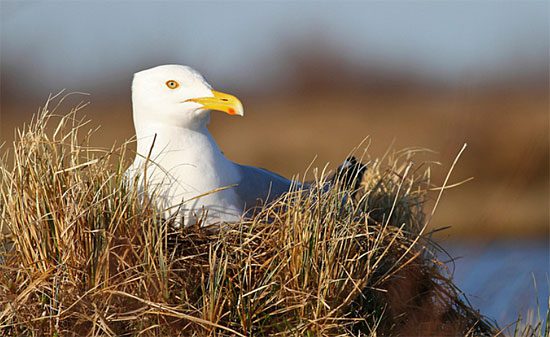Fire Ants Attack Herring Gulls on Maine Island
By Luke DeFisher
October 15, 2011

Just two days after final exams ended in May, I was on a boat headed to Appledore Island, Maine. Starting in mid May, I’d be on that tiny, rocky island for two months, along with five other interns in the Research Internship in Field Science (RIFS) program at Cornell’s Shoals Marine Lab. Gulls were dive-bombing my head, but I had ants on my mind.
Students on Appledore study everything from microbes to seals, but I was interested in an uninvited guest, the European fire ant. These ants have been on Appledore since the 1970s, and they sometimes attack Herring Gull nests, swarming over the chicks and stinging them. As a budding marine ecologist, I wondered if these individual attacks could take a toll on Appledore’s gull population as a whole.
It wouldn’t be the first time an ant affected a bird species. The closely related red fire ant has hurt Northern Bobwhite populations in southeastern Texas, and the big-headed ant threatens Wedgetailed Shearwaters in Hawaii. European red ants arrived in New England in 1908, and have been an expensive and growing problem for New England homeowners ever since.
I marked out 78 Herring Gull nests and spent the summer recording the chicks’ daily growth and survival for a long-term project run by my adviser, David Bonter, assistant director of Citizen Science at the Cornell Lab of Ornithology. With two to three chicks to a nest, I had a lot to monitor. I paid extra attention to 43 of those nests and saw ant attacks at 17 of them. Adult Herring Gulls preened and shook their feathers as the ants crawled over them. For young chicks the threat was greater, as scores of shiny, rust-colored ants covered the chicks’ eyes and tiny bills. Amazingly camouflaged from larger predators, the chicks’ gray-speckled feathers did little to hide them from six-legged invaders.
Most of the chicks survived ant attacks, but four nests—about nine percent of my sample—lost at least one chick. Keep in mind that the 43 nests I studied were only a fraction of the Herring Gull nests on Appledore that summer. Ants aren’t exactly driving Herring Gulls off the island—at least 600 pairs nest on Appledore. Still, I’d like to explore the magnitude of this ant-sized problem a bit further.
On top of fieldwork, I had to adjust to living on an island for eight weeks. With only one well, I became much more aware of my water and power use. Believe me, when you only get two showers a week and gulls have been making their excremental “mark” on you for three days straight, you learn to make every drop count. My project really broadened my horizons, because I was able to research two radically different kinds of animals. Thanks to the opportunity to conduct fieldwork at Shoals, I plan to keep studying the secret and surprising dynamics between ants and birds.
About the Author
Luke DeFisher is a junior in the Ecology and Evolutionary Biology department at Cornell University.
Originally published in the Autumn 2011 issue of BirdScope.


All About Birds is a free resource
Available for everyone,
funded by donors like you




